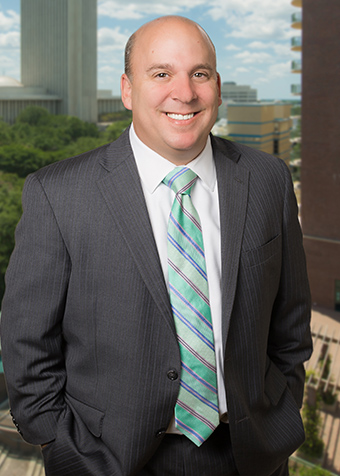Russian money flowing into America is having a corrupting effect. Wondering how many Russian companies have been investing in local development projects in St. Johns County and St. Augustine?
Florida lawmaker’s former company used Manafort to pitch Russian-developed technology to U.S. government
TALLAHASSEE — Paul Manafort’s Russian ties have cast a broad shadow over a Trump administration under investigation, but the longtime Republican powerbroker also has a little-known connection to a Florida politician that also runs, in part, through Russia.
Florida House freshman Don Hahnfeldt ran a company in the early 2000s that hired Manafort — President Donald Trump’s former campaign chief who was recently indicted — to try to sell Russian-developed nuclear containment foam to the U.S. Energy Department. At one point, a Manafort-directed company bought more than 2 million shares of company stock.
The story of the now-defunct, Virginia-based EuroTech Ltd. doesn’t just involve Russia — it’s also ingrained with other obscure plot elements worthy of the silver screen, including officials with known ties to the mafia and an untraceable cash flow from Cayman Island investors, according to thousands of pages of regulatory filings.
The documents underscore the reach of Manafort’s business and lobbying network — even into the orbit of a low-profile Florida state lawmaker, who was then in private industry. None of the EuroTech connections link to special counsel Robert Mueller’s investigation into Russia’s interference in the 2016 election.
Hahnfeldt, a Villages Republican whose 32-year Navy career included commanding nuclear submarines, said he was hired by EuroTech to help get the company’s most promising product, a Russia-developed nuclear containment foam tested at the Chernobyl nuclear disaster site, to market. Hahnfeldt, who was with the company from 1999 to 2003, said that never happened, but stands behind the product’s effectiveness.
A big part of the company’s strategy was lobbying for federal contracts with former President George W. Bush’s Energy Department. And that’s where Manafort, a longtime political operative and lobbyist, came in.
“He knew a lot of people,” Hahnfeldt told POLITICO. “We used him as a contact with the administration to try to promote the product, and get us access to the administration.”
Manafort’s firm — Davis Manafort — signed two separate one-year consulting agreements with EuroTech covering 2000 and
2001. During that time, Hahnfeldt was president and CEO of the company, and his name appears on the contracts. He said Manafort came in after much of the work with the Russians was complete. Manafort’s focus, Hahnfeldt said, was opening doors in the federal government.
“He helped us get some meetings,” he said of his former company’s work with Manafort, “but it was never as successful as we would have hoped.”
A copy of the 2001 contract reviewed by POLITICO showed that Davis Manafort was paid $300,000 and 4 percent of sales tied to the agreement. Manafort was never a registered lobbyist for the company, according to federal lobbying records.
Manafort went on to chair Trump’s successful 2016 presidential campaign. As it became clear the Russian government was interfering in U.S. elections, Manafort’s past work for politicians in Ukraine supportive of Russian President Vladimir Putin, and Russian financial ties, came under scrutiny. He is now facing a 12-count federal indictment, including conspiracy to a launder money, as part of Mueller’s investigation into the Russia’s involvement in the 2016 election.
The name of one of the offshore companies in the alleged Manafort money laundering network outlined in the Mueller indictment was John Hannah LLC. Its name is a near match to John Hanna LLC, a company that bought 2.5 million shares of EuroTech stock in 2001, when Manafort was a director, records show.
“The principals of John Hanna, LLC are the same persons who are the principals of Davis Manafort LLC, one of our consultants,” read SEC filings outlining the sale.
Hahnfeldt said he does not remember the stock sale or John Hanna LLC’s direct involvement with the company.
On the same date as the John Hanna LLC stock sale, 500,000 EuroTech shares were bought by another notable investor: Julius Nasso.
Nasso is a movie producer who in 2004 pleaded guilty to charges related to using his ties to the Gambino crime family to secure money owed to him by Steven Seagal, the action star and former Nasso business partner. Nasso served more than a year in prison.
Manafort’s firm and Nasso both purchased and sold EuroTech stock the same day. They collectively sold 1.5 million shares of stock in September 2001, two months after the original purchase, to “three individuals and one corporation,” according to SEC documents that don’t name the recipients.
The sale came during a year Manafort and Nasso would become business partners. In January 2001, Nasso helped launch Manhattan Pictures Intl., a Manhattan movie distribution company. The partnership helping build the company included “media and political strategist Paul Manafort of international business/financial company Davis Manafort,” reported Variety, a trade publication covering Hollywood and the movie industry.
Hahnfeldt, a 73-year-old former Sumter County Commissioner, said he had no direct contact with Nasso.
During two interviews, Hahnfeldt repeatedly said he did not deal with company finances, referring such questions to Chad Verdi, who was chairman of the board when John Hanna LLC purchased EuroTech stock. Attempts to reach Verdi through a movie production company he later founded were unsuccessful.
Several former company officials contacted by POLITICO either did not return requests seeking comment or said they did not have any direct knowledge of Manafort’s work.
During Manafort’s time consulting with the company, EuroTech did make some progress, including “substantial discussion” with officials at several Energy Department test sites and laboratories, and “had numerous meetings with DOE staff at their headquarters in Washington, DC and Germantown, MD,” according to documents EuroTech filed with the SEC.
The tests and initial positive feedback from federal officials gave EuroTech momentum after 2001. But it never got a foothold in the Energy Department.
The cash-strapped company fell well short of its $5 to $10 million in revenue for 2001 because of “overly optimistic” projections and the federal government’s changing priorities after the Sept. 11 terrorist attacks.
Russian roots
EuroTech was founded in 1995 as a “technology transfer” company that aimed to, in part, to commercialize “previously ‘classified’ technologies … developed by prominent research institutions and individual researchers in the former Soviet Union and in Israel.” Its initial goal was to sell those technologies in Central Europe, Ukraine, Russia and North America.
The company was founded with a four-person board led by president and CEO Randy Graves, a former computer developer and former longtime NASA official. Most of the founders were out by January 1998, when a new board was put in place, including Chairman James Watkins, who had served as President George H.W. Bush’s Energy secretary.
Though the company’s focus would later turn to selling its products to the U.S. government, in its formative years, it had a broader business portfolio. That included, among other things, working to build parking garages in Moscow, one of its earliest Russian business ties.
“I was working with the Kurchatov Institute in Moscow and it was a very interesting time,” he said. “That is probably how, or why, a struggling company like that was struggling in the United States was able to get the strategic rights to a technology like that.”
Hahnfeldt said his work with the institute is likely what helped EuroTech get the rights to the company and approval to transfer it to the United States.
In SEC filings, between 2000 and2002, company officials pitched an optimistic tone. Though it never met revenue expectations, company filings spoke of high expectations tied to things like being able to demonstrate a handful of its products, including the nuclear containment foam, at Energy Department test sites. That positive tone ended in its 2003 annual report filed with the SEC. Company officials highlighted successful tests, but noted they were not getting the company any revenue.
The company continued to operate until 2006, but by 2003 its most active days were behind it. It was the final year EuroTech filed an annual report with federal regulators.
Cayman Island cash
On its final SEC annual report, EuroTech outlined the $35 million in revenue it brought in from various sources since its inception. By far the biggest portion — $25 million — came from a Woodward LLC, a Cayman Island-based company of which little is known.
The company is tied to David Sims, who signed EuroTech regulatory filings along with Navigator Management Ltd., another Cayman Island-based company he controlled.
In 2003, while Sims was still involved with EuroTech, federal prosecutors said he was involved in a scheme to illegal “short selling” stock of Sedona, a Pennsylvania company, which filed a $2.6 billion federal lawsuit that was later settled.
Federal court documents filed by Sedona’s attorneys tied Sims to more than 50 offshore companies, and outline his involvement in other federal lawsuits.
“Sims is a known participant in illegal stock sales and stock manipulation schemes, who is also involved in Internet Law Library, Nanopierce and numerous other cases pending in the Southern District of New York,” read the lawsuit.
Sims never faced charges or SEC sanctions tied to the case.
Hahnfeldt said he remembers nothing of Woodward LLC, the offshore entity that provided roughly 70 percent of EuroTech’s working capital.
He again stressed that Verdi, the former company chairman-turned-movie-producer, handled the financial side, and said it was his job to oversee company operations.
“It was my role to try and take a strategic Russian technology and get approval for its transfer to the United States, and I’m pleased we were able to do that,” he said.















































